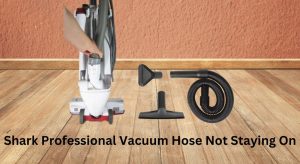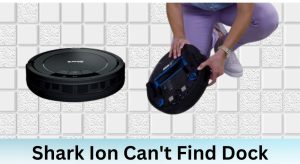Table of Contents
- Introduction
- 1. Power Issues: Why Won’t My Shark Vacuum Turn On?
- 2. Loss of Suction: How to Restore Your Shark Vacuum’s Power
- 3. Brush Roll Issues: Resolving a Stuck or Malfunctioning Brush Roll
- 4. Overheating Problems: Preventing Damage to Your Shark Vacuum
- 5. Strange Noises: Identifying and Addressing Unusual Sounds
- 6. Understanding Error Codes on Digital Displays
- 7. Tools and Materials for Troubleshooting
- 8. Preventing Future Problems: Maintenance Tips for Your Shark Vacuum
- FAQ Section
- Tips, Warnings, and Best Practices
- Conclusion
Introduction
Is your Shark vacuum cleaner suddenly refusing to cooperate? A malfunctioning vacuum can be frustrating, disrupting your cleaning routine and leaving you with a mess. Don’t panic! Many Shark vacuum issues are easily fixable at home with a little troubleshooting. This guide will walk you through the most common problems, providing step-by-step solutions to get your Shark vacuum back in action, so you can get back to enjoying a clean home. We will cover everything from simple fixes like checking the power cord to more involved solutions like clearing blockages and replacing filters, ensuring you have all the information you need to diagnose and resolve the problem.
Whether your Shark vacuum has lost suction, won’t turn on, or is making strange noises, this article will help you identify the root cause and guide you through the necessary steps to resolve the issue. With a little patience and some simple tools, you can often avoid costly repairs or replacements.
1. Power Issues: Why Won’t My Shark Vacuum Turn On?
If your Shark vacuum is completely unresponsive, the first step is to check the power supply. A simple power issue is often the culprit, and resolving it can save you time and money.
Check the Power Cord and Outlet
- Inspect the cord: Look for any visible damage such as cuts, frays, or exposed wires. A damaged cord is a safety hazard and needs to be replaced.
- Test the outlet: Plug another device into the same outlet to ensure it’s working. If the outlet isn’t functioning, check the circuit breaker or try a different outlet.
Reset the Motor (If Applicable)
Some Shark vacuums have a motor reset button. If your vacuum has this feature, follow these steps:
1. Unplug the vacuum from the power outlet.
2. Locate the motor reset button (usually on the vacuum body).
3. Press and hold the reset button for a few seconds.
4. Plug the vacuum back in and try turning it on.
2. Loss of Suction: How to Restore Your Shark Vacuum’s Power

A loss of suction is a common problem with vacuums. Here’s how to troubleshoot and restore your Shark vacuum’s suction power.
Empty the Dust Cup
- A full dust cup is the most common cause of reduced suction. Empty the dust cup after each use to maintain optimal performance.
- Ensure the dust cup is properly sealed after emptying.
Clean or Replace Filters
- Locate the filters: Shark vacuums typically have pre-motor and post-motor filters. Refer to your vacuum’s manual for their exact location.
- Clean the filters: Remove the filters and gently tap them to remove loose dirt and debris. Wash the pre-motor filters with water and allow them to dry completely (at least 24 hours) before reinstalling.
- Replace if necessary: If the filters are damaged or excessively dirty, replace them. Refer to your owner’s manual for the correct filter replacement schedule.
Check for Blockages in the Hose and Attachments
- Detach the hose: Disconnect the hose from the vacuum body and the wand or floor nozzle.
- Inspect for obstructions: Look for any blockages in the hose, wand, or floor nozzle. Use a broom handle or similar tool to dislodge any debris.
- Clear clogs: Pay special attention to areas where the hose bends or narrows, as these are common spots for clogs to form.
3. Brush Roll Issues: Resolving a Stuck or Malfunctioning Brush Roll
The brush roll is essential for agitating carpets and picking up debris. If it’s not working correctly, your vacuum won’t clean effectively.
Check for Tangled Hair and Debris
- Unplug the vacuum: Always unplug the vacuum before inspecting or cleaning the brush roll.
- Remove the brush roll cover: Use a screwdriver to remove the cover, if necessary.
- Cut away tangled hair: Use scissors or a seam ripper to carefully cut away any hair, string, or fibers wrapped around the brush roll.
- Clean the brush roll: Remove any remaining debris from the brush roll and the surrounding area.
Reset the Brush Roll Motor (If Applicable)
Some Shark vacuums have a brush roll reset button. If your vacuum has this feature:
1. Unplug the vacuum.
2. Locate the brush roll reset button (usually near the brush roll housing).
3. Press and hold the reset button for a few seconds.
4. Plug the vacuum back in and test the brush roll.
4. Overheating Problems: Preventing Damage to Your Shark Vacuum
Overheating can damage your Shark vacuum’s motor. Here’s how to prevent overheating and what to do if it occurs.
Identify the Cause of Overheating
- Check for blockages: Overheating is often caused by blockages in the hose, filters, or brush roll.
- Avoid prolonged use: Continuous use for extended periods can cause the motor to overheat.
Let the Vacuum Cool Down
- Unplug the vacuum: If your vacuum overheats, unplug it immediately.
- Allow it to cool: Let the vacuum cool down for at least 30 minutes before using it again.
Clean the Vacuum Thoroughly
- Empty the dust cup: Ensure the dust cup is empty.
- Clean the filters: Clean or replace the filters as needed.
- Check for blockages: Inspect and clear any blockages in the hose, brush roll, and other components.
5. Strange Noises: Identifying and Addressing Unusual Sounds
Unusual noises coming from your Shark vacuum can indicate a problem. Here’s how to diagnose and address these sounds.
Types of Noises and Their Potential Causes
- Screeching or squealing: Often caused by a worn belt or a blocked brush roll.
- Rattling: May indicate loose parts or debris in the motor housing.
- Loud humming: Could be a sign of a motor issue or a blockage in the airflow.
Inspecting and Cleaning the Vacuum
- Unplug the vacuum: Always unplug the vacuum before inspecting it.
- Check for loose parts: Tighten any loose screws or connections.
- Clear obstructions: Remove any debris that may be causing the noise.
Replacing Worn Parts
- Check the belt: If your vacuum has a belt, inspect it for wear and tear. Replace it if necessary.
- Consult a professional: If the noise persists, it may be a sign of a more serious motor issue. Consider consulting a qualified repair technician.
6. Understanding Error Codes on Digital Displays
Some Shark vacuums come with digital displays that show error codes. These codes can provide valuable information about the problem.
Common Error Codes and Their Meanings
- Refer to your owner’s manual for a list of error codes specific to your model. Common codes may indicate issues with the brush roll, motor, or sensors.
Steps to Take When an Error Code Appears
- Consult the manual: Look up the error code in your owner’s manual to understand the problem.
- Try the recommended solution: Follow the troubleshooting steps recommended in the manual.
- Contact customer support: If the error code persists, contact Shark customer support for further assistance.
7. Tools and Materials for Troubleshooting
Having the right tools on hand can make troubleshooting much easier. Here’s a list of helpful items:
- Screwdrivers: Various sizes for removing covers and accessing components.
- Scissors or seam ripper: For cutting away tangled hair from the brush roll.
- Broom handle or similar tool: For dislodging blockages in the hose.
- Cleaning cloths: For wiping down parts and removing dirt.
- Replacement filters: Keep a spare set of filters on hand for quick replacements.
- Owner’s manual: Essential for understanding your vacuum’s specific features and error codes.
8. Preventing Future Problems: Maintenance Tips for Your Shark Vacuum
Regular maintenance can prevent many common issues and extend the life of your Shark vacuum.
Regular Cleaning and Maintenance
- Empty the dust cup after each use: This prevents the buildup of debris and maintains optimal suction.
- Clean the filters regularly: Wash or replace the filters as recommended in your owner’s manual.
- Check for blockages: Inspect the hose, brush roll, and attachments regularly for any obstructions.
- Store the vacuum properly: Store the vacuum in a clean, dry place to prevent damage and maintain its performance.
Following Manufacturer’s Recommendations
- Read the owner’s manual: Familiarize yourself with the manufacturer’s recommendations for maintenance and troubleshooting.
- Use recommended parts: Only use genuine Shark replacement parts to ensure optimal performance and prevent damage.
FAQ Section
Why does my Shark vacuum smell bad?
A bad smell often indicates trapped dirt, mold, or mildew. Clean the dust cup and filters thoroughly, ensuring they are completely dry before reassembling. You can also try vacuuming a small amount of baking soda to neutralize odors.
How often should I replace the filters in my Shark vacuum?
Filter replacement frequency depends on usage, but generally, pre-motor filters should be cleaned every 3 months and replaced every year. Post-motor filters should be replaced every year. Check your owner’s manual for specific recommendations.
My Shark vacuum’s brush roll isn’t spinning. What should I do?
First, unplug the vacuum and check for tangled hair or debris around the brush roll. Remove any obstructions and try resetting the brush roll motor if your model has one. If the problem persists, the belt may be broken and need replacement.
Can I use my Shark vacuum without the filters?
No, you should never use your Shark vacuum without the filters. Filters protect the motor from dust and debris. Operating without filters can cause significant damage and void your warranty.
What does it mean if my Shark vacuum is pulsing?
Pulsing usually indicates a blockage or airflow restriction. Check the dust cup, filters, hose, and attachments for clogs. Clear any obstructions and ensure all parts are properly connected and sealed.
How do I clean the hose of my Shark vacuum?
Detach the hose from the vacuum and use a broom handle or similar tool to push any blockages through. You can also rinse the hose with water and mild detergent, ensuring it’s completely dry before reattaching it.
Tips, Warnings, and Best Practices
- Always unplug the vacuum before performing any maintenance or troubleshooting steps.
- Never submerge the vacuum body in water or other liquids.
- Use only genuine Shark replacement parts to ensure compatibility and optimal performance.
- Avoid vacuuming up liquids or sharp objects that could damage the vacuum.
- Clean your vacuum regularly to prevent the buildup of dust and debris.
- If you’re uncomfortable performing repairs yourself, consult a qualified appliance repair technician.
Conclusion
Troubleshooting a Shark vacuum that isn’t working can seem daunting, but with this guide, you can confidently diagnose and resolve many common issues. From power problems and loss of suction to brush roll malfunctions and overheating, understanding the potential causes and solutions will save you time and money. Remember to follow the maintenance tips to keep your Shark vacuum running smoothly for years to come, so you can keep your home clean and healthy. If you’ve exhausted these troubleshooting steps and your vacuum still isn’t working, it may be time to contact Shark customer support or consider professional repair services.






